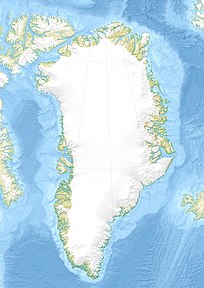Nuugaatsiaq
| Nuugaatsiaq (medium large headland) | ||
|---|---|---|
| Nûgâtsiaĸ | ||
| Commune | Avannaata Communia | |
| District | Uummannaq | |
| Geographical location | 71 ° 32 '13 " N , 53 ° 12' 36" W | |
|
|
||
| Residents | 0 (2020) |
|
| founding | 1925 | |
| Time zone | UTC-3 | |
Nuugaatsiaq [ ˌnuːˈɣaːt͡sːiɑq ] (according to the old spelling Nûgâtsiaĸ ) is a desolate Greenlandic settlement in the district of Uummannaq in the Avannaata Kommunia .
location
Nuugaatsiaq is located in the south of the island of Qeqertarsuaq , which should not be confused with the disco island of the same name . On the island is the mountain Snehætten (Nuugaatsiap Qaqqaa). To the west of the village is the small archipelago of Qeqertannguit . The Torsuuk Strait in front of the town separates Qeqertarsuaq from the island of Karrat .
history
Nuugaatsiaq was probably settled shortly after 1918. In 1923, it was proposed in Grønlands Landsråd to split up the Illorsuit parish . A new Udsted had to be built for this. In 1925 Nuugaatsiaq received Udsteds status and in the same year an apartment was built for the Udsteds administrator. In 1926 the place received a school band. In 1930 Nuugaatsiaq already had 119 inhabitants. In the same year a store and warehouse was built and in 1936 a packing house. In 1960 the population reached its maximum with 159 people.
On June 18, 2017, the town was named after a by a landslide triggered earthquakes of intensity 4.8 of a tsunami struck. Four people were dragged out to sea and killed, two seriously injured and seven others lightly. Eleven buildings were also destroyed, including the power station. Nuugaatsiaq and Illorsuit were subsequently evacuated because they were in the danger zone for another tsunami. Since then, both places are no longer allowed to be inhabited.
economy
Nuugaatsiaq lately lived mainly from halibut fishing , while seal hunting and cat fishing were still some time ago . A small trading branch of Royal Greenland with a maximum of ten employees stored the fish. Other professions could be found in administration, Pilersuisoq , tourism and the Atuarfik Saamu school , which taught twelve students in grades one to nine and also offered a library and youth activities. There was also day care, the post office, an infirmary and a village hall.
Infrastructure and supply
There is a small quay on the eponymous headland. The boats were usually started directly at the water's edge. In the north is the Nuugaatsiaq heliport . In winter, the traffic was by snowmobile and dog sled. There are some cobbled streets in the village.
Nukissiorfiit supplied the town with electricity from the power station in the east and fresh water from a tank. Garbage was burned or dumped in the sea. TELE Greenland took care of the telecommunications .
Development
In Nuugaatsiaq there was a Pilersuisoq branch, the Atuarfik Saamu school , which taught twelve students in grades one to nine and also offered a library and youth activities. There was also day care, the post office, an infirmary and a village hall. There are a large number of protected buildings in the village, the oldest of which was built in 1850.
Population development
The population of Nuugaatsiaq has been almost constant over the past few decades. Since the tsunami, the place is no longer allowed to be inhabited.

Web links
Individual evidence
- ↑ Map with all official place names confirmed by Oqaasileriffik , provided by Asiaq
- ↑ Jens Christian Madsen: Udsteder og bopladser i Grønland 1901-2000 . Atuagkat, 2009, ISBN 978-87-90133-76-4 , pp. 164 f .
- ↑ a b c Nugaatsiaq at qaasuitsup-kp.cowi.webhouse.dk
- ↑ Population of Nuugaatsiaq 1977–2020 at bank.stat.gl


